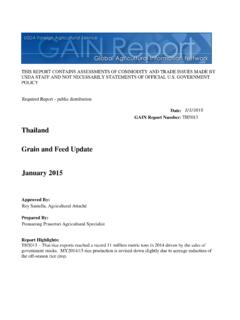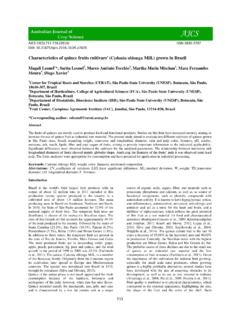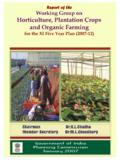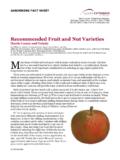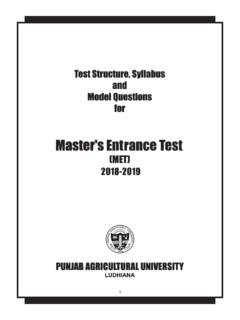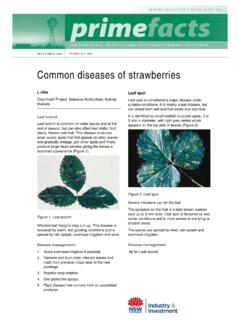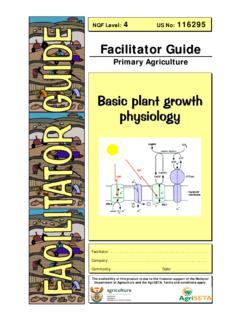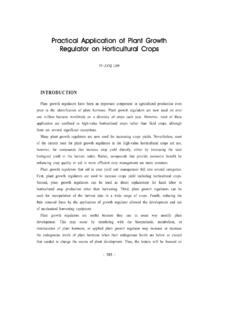Transcription of TOMATO 1. Introduction World Scenario - Agri Exchange
1 TOMATO 1. Introduction TOMATO ranks third in priority after Potato and Onion in India but ranks second after potato in the World . India ranks second in the area as well as in production of TOMATO . World Scenario The major TOMATO growing countries are China, USA, Italy, Turkey, India and Egypt. Total area under TOMATO is 4582438 thousand ha with production of 150513813 thousand tons and with productivity of tons/ha. The latest area, production and productivity of major TOMATO growing countries in 2010 - 2011 is given below in the table. Major TOMATO Producing Countries In The World (2010-11) Country Area ( 000ha) Production ( 000 Tons) Productivity (tons/Ha) % Share Of World Production China 871235 41879684 28 India 865000 16826000 11 U S A 159200 12902000 9 Turkey 304000 10052000 7 Egypt 216385 8544990 6 Italy 118822 6024800 4 Iran 146985 5256110 3 Spain 58300 4312700 3 Brazil 60772 3691320 2 Mexico 98189 2997640 2 Others 1683550 38026569 25 World Total 4582438 150513813 100 Indian Horticulture Database 2011 Indian Scenario There is a sizeable increase in acreage and production of TOMATO in India.
2 There is an increase from thousand ha in 2006-07 to thousand ha in 2010-11, while in terms of production it has increased from to thousand tons. Showing the Area, Production and Productivity of TOMATO in India YEAR Area (000 ha) Production ( 000 tons) Productivity (tons/ha) 2006-07 2007-08 2008-09 2009-10 2010-11 Source: Indian Horticulture Database 2011 2. Major Producing States with Production of Last Three Years Area, Production and Productivity of Leading TOMATO Growing States in India STATEWISE AREA, PRODUCTION AND PRODUCTIVITY OF TOMATO State AREA IN 000' HA PRODUCTION IN 000' MT PRODUCTIVITY HA/MT % Share in Production 2008-09 2009-10 2010-11 Area Production Pdy. Area Production Pdy. Area Production Pdy. Andhra Pradesh Karnataka Orrisa Maharashtra West Bengal Bihar Gujarat Chhatishgarh Tamilnadu Jharkhand Others TOTAL Source : National Horticulture Board -2011 3.
3 Description of some commercial TOMATO Varieties Shows the varietal characteristics of commercially grown TOMATO varieties Variety/ Type Characteristics ARTH-3 Plants determinate; fruits large, squarish round, deep red, compact; uniform ripening, harvesting starts after 80-85 days and continues upto 160-180 days; gives an average yield of 88-95 tons/ha. Suitable for table purpose. Avinash-2 Heavy yielder, determinate, compact growing hybrid. Fruits semi oblong, medium sized, good coloured, uniform ripening. Pusa Hybrid-1 Plants are determinate; compact with good foliage cover and prolific bearing; ruits are round, smooth and attractive. It has an added advantage of providing TOMATO from June to mid July. Pusa Hybrid 4 Plants are determinate, compact with dark green foliage, good foliage cover; fruits are attractive, round smooth, average weight of 70-80grams and it shows uniform ripening, good for long transportation. Average yield 550 Qtl/Ha. Vishal Arka Plants are determinate; fruits are round, firm, deep red with green shoulder, average weight of 140 gram; tolerant to fruit cracking; matures in 160 days with an average yield of 75tons/Ha.
4 4. Good Agricultural Practices (GAP) Raising of seedlings. Nutrient management. Use of plant growth regulators for better yield. Plant protection. 5. Harvesting Season of Crop in Leading States -Lean Period -Peak Period - Throughout Year STATE/UT S JAN FEB MAR APR MAY JUN JUL AUG SEP OCT NOV DEC Andhra Pradesh Karnataka Orrisa Maharashtra West Bengal Bihar Gujarat Chhatishgarh Tamilnadu *The above graph shows harvest pattern in leading TOMATO growing states. 6. Arrival pattern in market In Gujarat and Maharashtra tomatoes are available round the year in one pocket or the other. By adopting suitable agro techniques, the TOMATO can be made available throughout the year. Month wise availability of TOMATO Period of Harvest Areas January- March Bihar, Eastern UP, MP, Orissa, foot hills of Uttarakhand, Andhra Pradesh, Assam April- May Haryana, Punjab, Karnataka, Rajasthan June-July Uttarakhand, Tamil Nadu, Punjab, Gujarat August-September Andhra Pradesh, Himachal Pradesh, Uttarakhand, Maharashtra, Gujarat October-November Chattisgarh, Tamil Nadu December Andhra Pradesh, Rajasthan, Chattisgarh, Madhya Pradesh, Orissa, Rajasthan 7.
5 (a) Concentrated Pockets The details of concentrated pockets of TOMATO in different states are listed below: Shows concentrated pockets of TOMATO in TOMATO growing states. State Districts Maharashtra Nasik, Ahmednagar, Pune, Sholapur, Satara, Sangli, Nagpur. Karnataka Kolar, Banglore, Belgaum. Andhra Pradesh Kurnool, Rangareddy, Prakasam, Mehboobnagar. Bihar Muzzaffarpur, Vaishali, Mandya. West Bengal Puralia, Nadia, Bankura, Burdhman Tamil Nadu Dharmapuri,Salem Gujarat Valsad, Surat, Navsari, Kheda, Ahmedabad. (b) Catchment Areas of Market Showing the details of catchment Areas of Markets of TOMATO in Leading States States Districts (Market) Blocks Maharashtra Pune Junnar, Ambegaon, Ghod, Rajgurunagar, Wadgaonsirur, Mulshi, Welhe, Purandhar, Bhor, Baramati, Indapur, Daund, Saswad. Nasik Kalvan, Peint, Igatpuri, Sinnar, Niphad, Yeola, Nandgaon, Satana, Furgana, Dindori, Melgaon. Satara Mahabaleshwar, Khandala, Wai, Phaltan, Koregaon, Khata, Patan, Karad, Vadug Sangli Atpadi, Khanapur, Islampur, Shirala, Valva, Tasgaon, Kavathe, Mahankal Karnataka Bangalore Sonnenahali, Bettenhalli, Chokkanhalli, Baglur, Nagarur,Shivanapura, Tavarkere, Maragondahalli, Anekal Belgaum Athni, Arkali, Chikodi, Mukeri, Bailhongal, Ramdurg, Khauapur Andhra Pradesh Kurnool Emmiganuru, Kappagalu, Alur, Adoni, Atmakpur, Pattikonda, Dhone, Koilkuntla, Banganpalli, Allagadda Prakasam Erragondapalem, Markopur, Giddalur, Tarlupadu, Podile, Darsai, Baulipali, Chundi Mehboobnagar Kollur, Keshampat, Mughalgidda, Karnul, Wanparti, Atmakur, Gadwall, Alampur, Kolhapur, Achampet, Kondangol.
6 Bihar Muzzaffarpur Sahebganj, Baruraj, Hursepur, Minapur, Kanti, Parui, Paruii, Kurhani, Sacra, Dholi, Bochacha, Gaihati, Katra, Aurai Vaishali Kalyanpur, Lalganj, Goraul, Mahuwa, Patepur, Desri, Bidpur West Bengal Puruliya Jhalida, Jalpur, Para, Nituria, Santuria, Kashipur, Hura, Puncha, Manbazar, Baghmundi, Raghunathpur. Nadia Karimpur, Tehata, Kaliganj, Nakasipara, Chapra, Krishnanagar, Shantipur, Ranaghat, Chakdaha, Kalyani. Tamil Nadu Dharmapuri Pennagaram, Harur, Pappireedipatti, Palakkodu, Pochampalli Salem Mettur, Yercaud, Idappadi, Omalpur, Attur, Gangavalli, Sankagiri Gujarat Valsad Kadiyan, Zoz, Kikawada, Nimeta, Tundav, Kadachhala, Nasvadi, Kwant, Dabhoi. Karjan, Sinor, Ambadunger, Vadodara, Sankheda Surat Mangrol, Umarwada, Nizer, Olpal, Kamrej, Mahuva, Valod, Bardoi, Buhari, Umra, Tadkeshwar. Ahmedabad Mandal, Rampura, Samand, Bavia, Dholka, Dhandhkulla, Ranapur 8. Criteria and description of grades Details of grade designation and sizing of TOMATO as per AGMARK standard Grade Designation Grade Requirements Provision concerning sizing Grade Tolerances 1 2 3 4 Extra class Tomatoes shall be of superior quality.
7 They shall have firm flesh and must be characteristics of the variety as regards shape, appearance of the produce, the quality, the keeping quality and presentation in the package. As per table A 5% by number or weight of tomatoes not satisfying the requirement of the grade, but meeting those of class I or exceptionally, coming within the tolerances of that grade. Class I Tomatoes shall be of good quality. They shall have reasonably firm flesh and shall be characteristics of the variety as regards shape, appearance and development. They must free of cracks and visible green back. The following slight defects may be there provided these do not affect the general appearance of the produce, the quality, the keeping quality and the presentation in the package. -a slight defect in shape and development; -a slight defect in colouring; -slight skin defects; -very slight bruises; ribbed tomatoes may show: -no excessive protuberances; -small nonlignified umbilical scars -Suberization of the stigma upto 1 sq.
8 Cm -no more than 1 headed scar -umbilical lignified scars not greater than 1 or linear scar no longer than 2/3 rd of the greatest diameter of the fruit As per table A 10% by number or weight of tomatoes not satisfying the requirements of the grade, but meeting those of class II or, exceptionally, coming within the tolerances of that grade. Class II Tomatoes shall be reasonably firm flesh and shall be characteristic of the variety( but may be slightly less firm than in class I) and must not show unhealed cracks. Following defects may be there provided the tomatoes retain their essential characteristics as regards the quality, the keeping quality and presentation. -defects in shape, development and colouring; - skin defects or bruises, provided the fruit is not seriously affected; - healed cracks not more than 3 cm in length. ribbed tomatoes may show: -more pronounced protuberances but without being misshapen; - one umbilicus; -umbilical lignified scars not greater than 2 sq.
9 Cm; - fine blossom scar in elongated form. As per table A 10% by number or weight of tomatoes not satisfying the requirements of the grade, but meeting the minimum requirements. In case of trusses of tomatoes, 10%by number or weight of tomatoes detached from the stalk. PROVISION CONCERNING SIZING Sizing is determined by the maximum diameter of the equatorial section in accordance with following table. The provision shall not apply to cherry tomatoes. The minimum size is set at 35 mm for round and ribbed tomatoes and 30 mm for oblong tomatoes: Details of sizing in Pomegranate Fruits Size Code Diameter in mm (minimum - Maximum) 1 30 - 34 2 35 - 39 3 40 - 46 4 47 - 56 5 57 - 66 6 67 - 81 7 82 - 101 9. Packaging & its details For export purpose, TOMATO is first packed in consumer packs of LDPE or PP (polypropylene). Twenty consumer packs of 250 gm are placed in a 5 Kg CFB box. The specification details of CFB box is given below: Box Size Dimension 1 5 Kg Box 450X265X110 mm The details specifications are given below in the table : Specification details for Corrugated Fiber Board (CFB) Boxes for packing TOMATO for Exports Specification Slide Type Ring *Flap Tuck-In-Type RSC(REGULAR SLOTTED CONTAINER) Tray with LID 1 Material for construction 5-ply CFB 5-ply CFB 5-ply CFB 5-ply CFB 2 Grammage (g/m sq.)
10 (outer to inner) *230X140 X140X140 *230X140 X140X140 *230X140 X140X140 *230X140 X140X140 3 Bursting strength kg/cm sq. Min. Min. Min. Min. 4 Puncture resistance inches/teat inch 5 Compression strength Kg. 6 Cobb (30 minutes g/m sq.) *Outer ply of white duplex board Source: Post- Harvest Manuals on Export of Fruits, APEDA, New Delhi. 10. Distribution of produce from primary to terminal market Most of the tomatoes are produced in Andhra Pradesh, Orissa, Karnataka and Maharashtra. TThe major markets of tomatoes are Kurnool, Prakasam, Bangalore, Belgaum, Nasik, Pune, Sangli and Nagpur. From above markets tomatoes reach markets of Mumbai, Bhopal, Lucknow, Delhi etc for further distribution. 11. Exports and export potential A. Domestic Strengths for Exporting TOMATO Domestic strengths for exporting Tomatoes are given below: India stands at fourth position in production of tomatoes next to China, And Turkey. Maximum production of tomatoes takes place in Andhra Pradesh, Orissa, Karnataka, Maharashtra, West Bengal, Bihar, Gujarat etc.


